Topics 2021
December 2021
Dec. 21, 2021 Updated
Ryugu is a primitive asteroid rich in water and organic matter: A first look at the unprocessed carbonaceous asteroid sample returned by Hayabusa2, published in Nature Astronomy
|
The first results from the initial description of the sample from asteroid Ryugu returned by the Hayabusa2 spacecraft have been published in the British online journal, Nature Astronomy (December 21, 2021 JST). 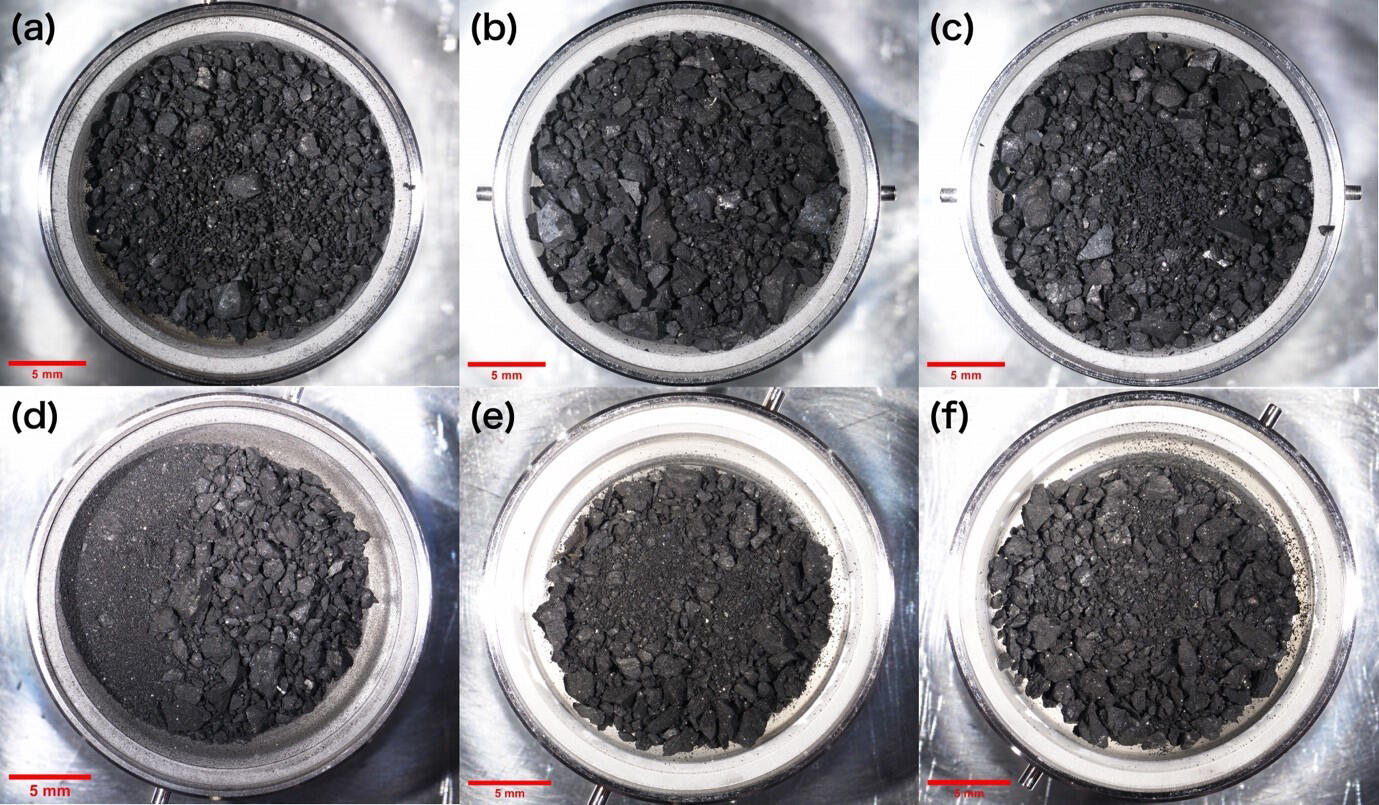
Click here for details: |
Dec. 20, 2021 Updated
Receiving the insignia of Chevalier of the Legion of Honor from the French Republic
|
Dr. YAMAKAWA Hiroshi, President of Japan Aerospace Exploration Agency (JAXA) received the insignia of Chevalier of the Legion of Honor from H.E. Philippe Setton, Ambassador of the French Republic to Japan on December 17. This insignia was presented to Dr. Yamakawa for his contribution in advancing space cooperation between France and Japan by launching new projects with CNES (Centre national d'études spatiales) in the areas such as space transportation and space exploration. Dr. Yamakawa have stated, “It is a great honor for me to receive the insignia of Chevalier of the Legion of Honor. There is a long-standing history of space cooperation between Japan and France, and I believe that I have received this award with our partners who have contributed to this partnership.” He expressed his expectations to contribute further deepening relations between the two countries through space cooperation. 
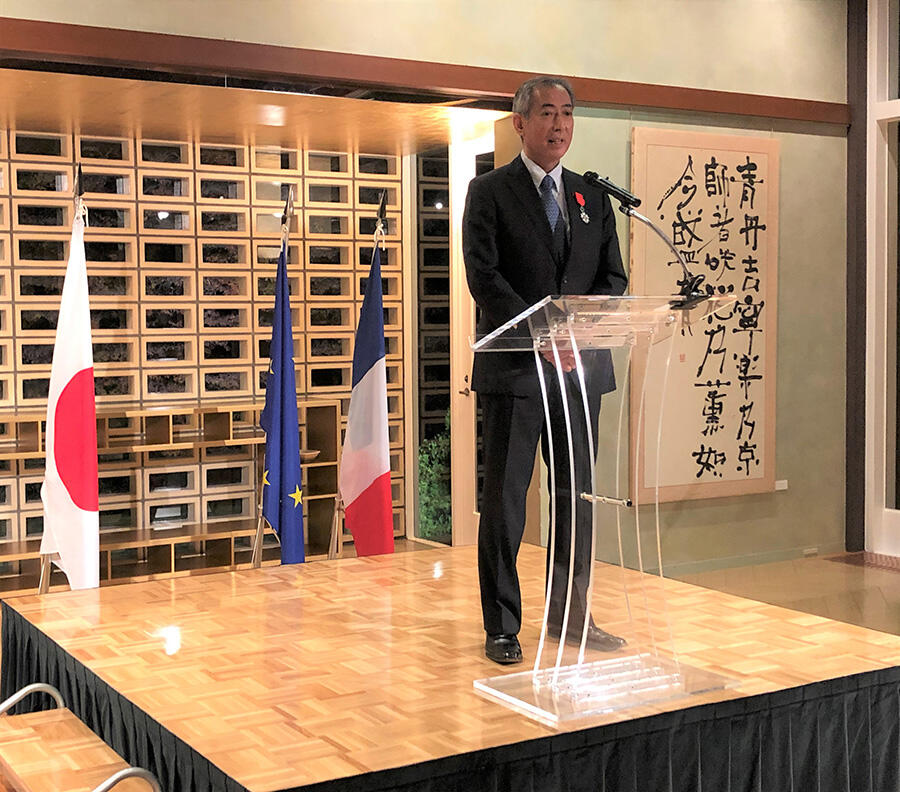
|
November 2021
Nov. 22, 2021 Updated
Receiving the National Order of Merit from the Republic of Paraguay
|
Dr. YAMAKAWA Hiroshi, President of Japan Aerospace Exploration Agency (JAXA) had received the National Order of Merit “José Falcon” from H.E. Dr. Euclides ACEVEDO CANDIA, Minister of Foreign Affairs of the Republic of Paraguay, during his visit to Japan on November 21. This award was presented to JAXA for the contribution of deploying the Republic of Paraguay’s first CubeSat “GuaraniSat-1” from the International Space Station (ISS) Japanese Experiment Module “Kibo” in March this year through the Joint Global Multi-Nation Birds Satellite project (BIRDS Project) which is conducted by Kyushu Institute of Technology. Dr. Yamakawa have stated, “We are honored that JAXA was able to play a part in welcoming the Republic of Paraguay to the exciting world of aerospace. I believe that we have received this award together with all students, teachers, and our partners, who have worked hard to make this (CubeSat mission) possible.” He expressed his expectations to contribute further deepening relations between the two countries through space cooperation. 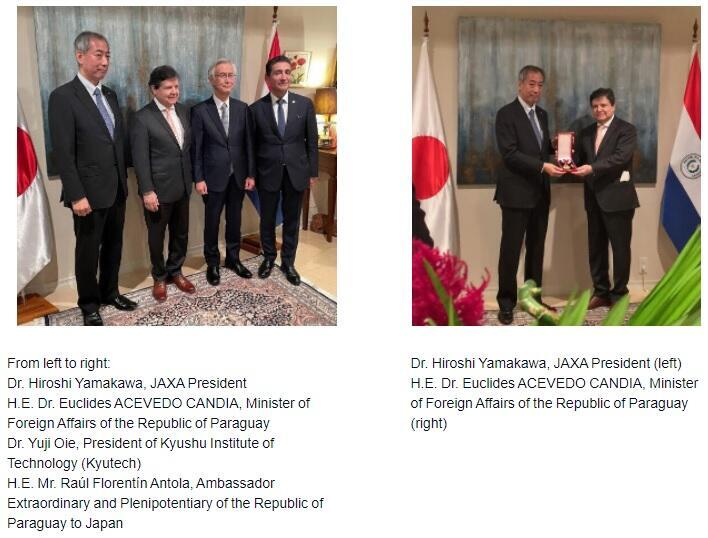
|
October 2021
Oct. 28, 2021 Updated
JAXA and Turkish Space Agency (TUA) Sign Memorandum of Cooperation
|
President Yamakawa of JAXA and President Serdar Huseyin Yildirim, Turkish Space Agency (TUA) have signed today a Memorandum of Cooperation (MOC) in the Field of Space Activities for Peaceful Purposes at the 72nd International Astronautical Congress 2021, Dubai, United Arab Emirates (UAE). The signing ceremony was graced by the presence of Consul General Mr. Ilker Kilic, Turkish Consulate General in Dubai and Consul General Mr. Sekiguchi, Consulate General of Japan in Dubai. JAXA has been building a close cooperative relationship with Turkey since before the establishment of TUA through the deployment of Turkish microsatellite from the Japanese Experiment Module "Kibo" on the International Space Station (ISS) and long-term exposure experiments (twice) of materials and other subjects using the Experiment Handrail Attachment Mechanism (ExHAM) of the Exposed Facility, an external platform outside the Japanese Experiment Module "Kibo" on the ISS in 2018. With the conclusion of this MOC, the two organizations will further strengthen their cooperation. 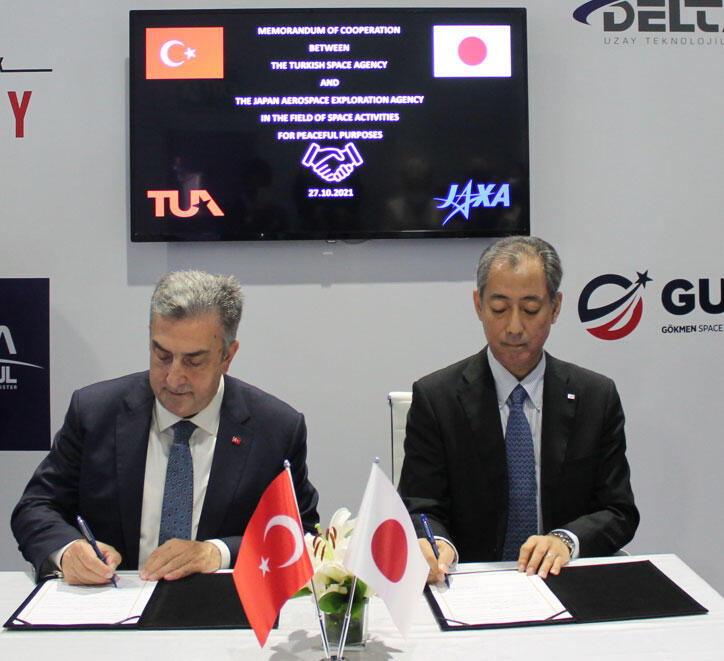
President Serdar Huseyin Yildirim, Turkish Space Agency (TUA) (Left) 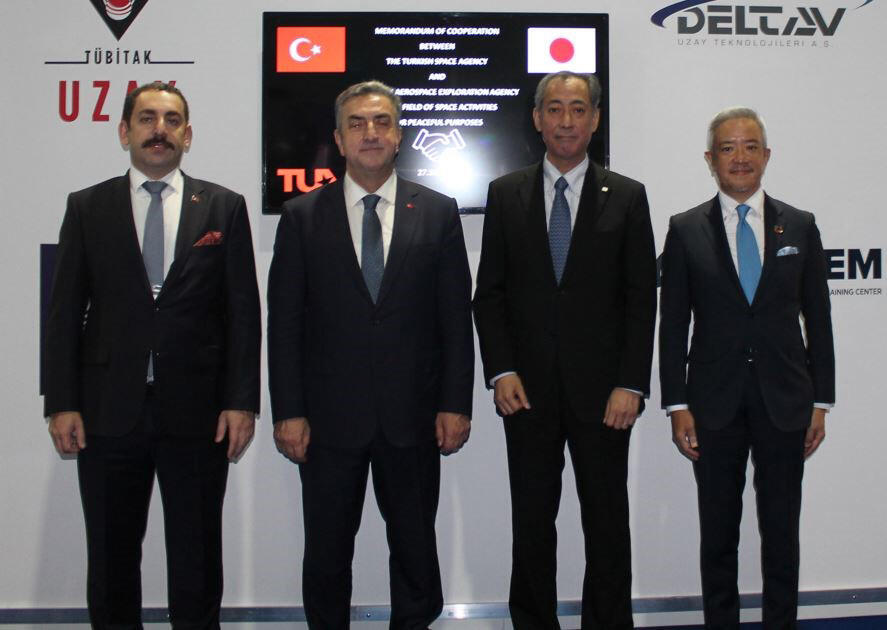
Consul General Mr. Ilker Kilic (Left) |
Oct. 27, 2021 Updated
JAXA, CSA and DLR Sign LoI on the establishment of a global Human Resources exchange network within Space Organisations
|
YAMAKAWA Hiroshi, President of Japan Aerospace Exploration Agency (JAXA), Lisa Campbell, President of Canadian Space Agency(CSA), and Anke Kaysser-Pyzalla, Chair of the German Aerospace Centre(DLR) Executive Board signed a Letter of Intent(LoI) on the establishment of a global Human Resources exchange network within Space Organizations, named “International Forum for Space Organisations Human Resources Management,” with “INFOHRM” as its official acronym, on October 26, 2021.
With the rapid technological development, the world's socio-economies are becoming closer and more connected to each other. In this era of Volatility, Uncertainty, Complexity, and Ambiguity, we are faced with the need to take on new challenges for the future, and space technology is no exception.
The purpose of this LOI is to establish among participating agencies an international forum for sharing information and best practices in Human Resources (HR) and HR-related Administration matters. At the signing ceremony, President Yamakawa expressed his expectation that the human resources policy, which is an important element of the organization, will be addressed as a common interest. 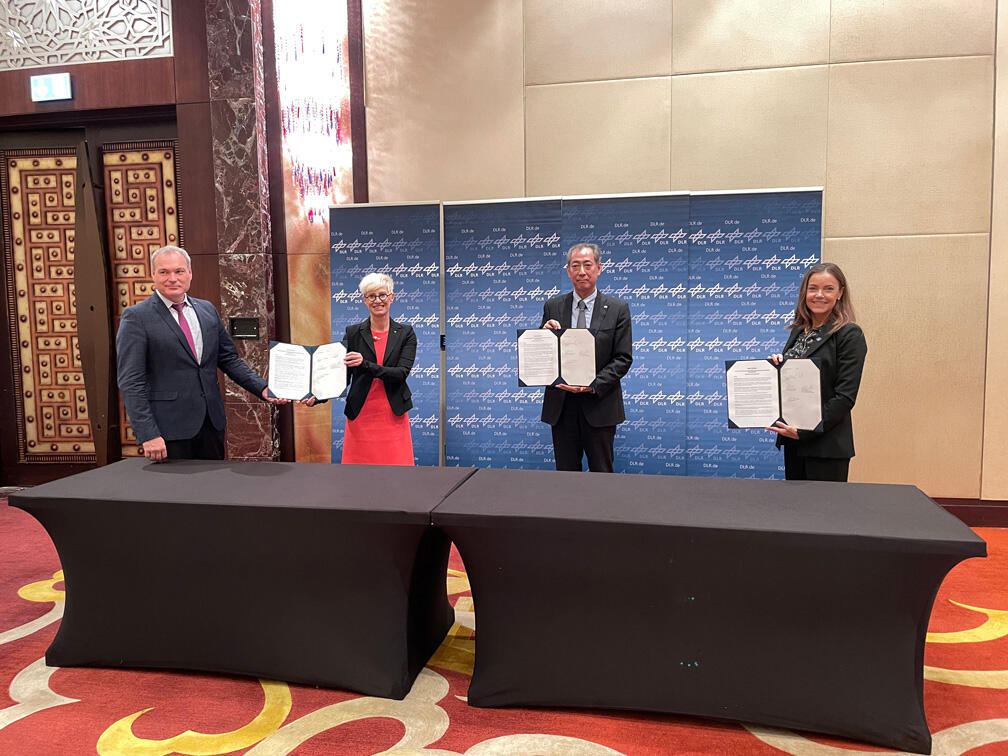
|
Oct. 25, 2021 Updated
JAXA and State Space Agency of Ukraine (SSAU) Signed Memorandum of Cooperation for the study of possible cooperation in the field of space activities for peaceful purposes
|
President Yamakawa of JAXA and Head of the State Space Agency of Ukraine (SSAU) Mr. Taftai Volodymyr have signed a Memorandum of Cooperation for the Study of Possible Cooperation in the Field of Space Activities for Peaceful Purposes (MOC) on 23rd October during the Expo 2020 Dubai thematic space week (Dubai, UAE). The signing ceremony was graced by the presence of H. E. Dr. Korsunsky Sergiy, the Ambassador Extraordinary and Plenipotentiary of Ukraine to Japan, and Mr. Otsuka Kazuya, Chargé d'affaires a.i., of Embassy of Japan in Ukraine. This MOC is aimed at exchanging information and studying possible cooperation in the broad areas of space exploration, space science, earth observation, and research and development. Under this MOC, JAXA and SSAU will discuss to create favorable conditions for the development of scientific and technical cooperation between the space communities of our two countries. 
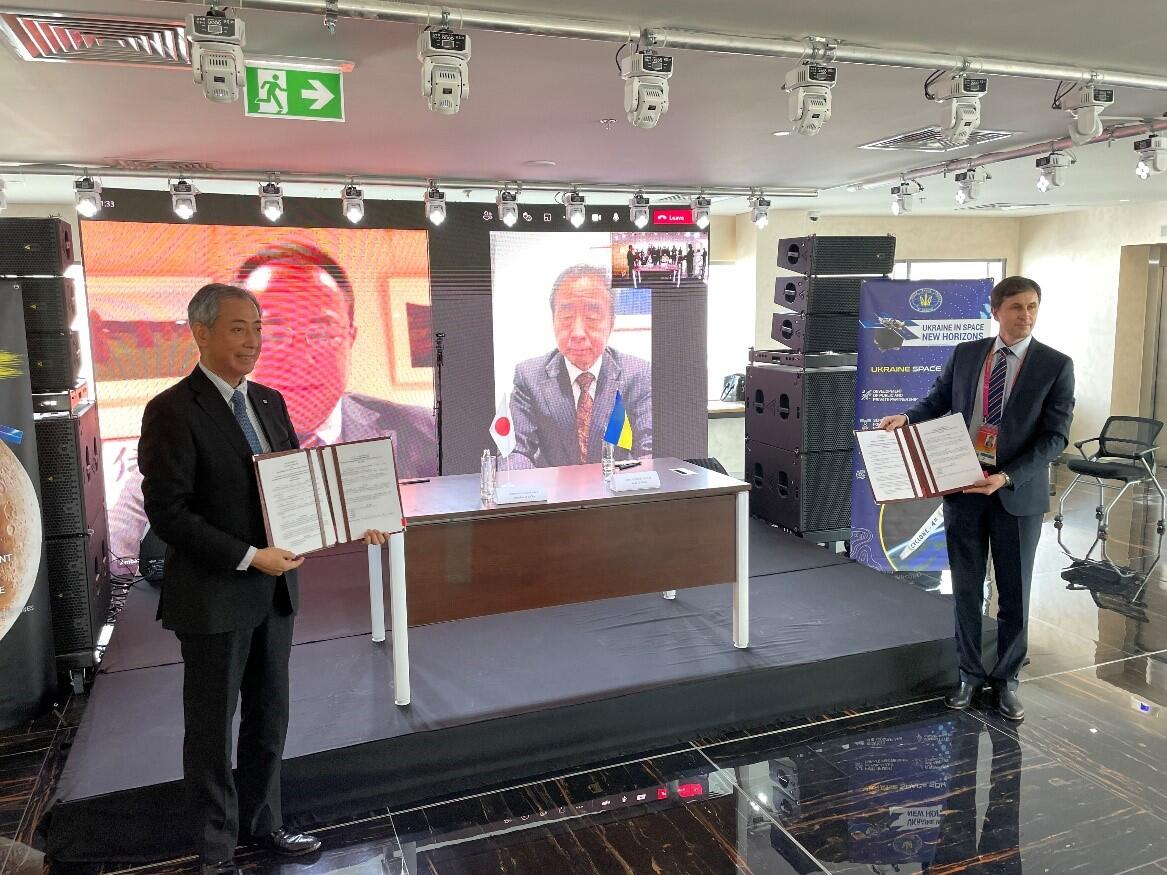
|
Oct. 22, 2021 Updated
Special Session on “Regional Cooperation and National Space Legislation” at IAC 2021 in Dubai!
|
The National Aeronautics and Space Administration (NASA), the European Space Agency (ESA) and the Japan Aerospace Exploration Agency (JAXA) initiated a collaborative effort aiming at establishment of the COVID-19 Earth Observing Dashboard in May 2020, and extended its scope to global environmental change later in March 2021. In May of this year, three years after the start of its initiative, Earth Observing Dashboard has reached the stage of total renewal. Noting the increasing use of the joint Dashboard and the continuous users’ requests for more information, NASA, ESA, and JAXA agreed to continue through June 2024 to advance their joint work in global understanding of the changing environment with human activities.
For the text of NASA-ESA-JAXA Joint Declaration:
Related Information:
|
August 2021
Aug. 5, 2021 Updated
Bilateral Meeting with NASA Administrator, Sen. Nelson
|
Dr. YAMAKAWA Hiroshi, President of Japan Aerospace Exploration Agency (JAXA) had an online meeting with National Aeronautics and Space Administration (NASA) Administrator, Sen. Bill Nelson on August 5, 2021. Dr. YAMAKAWA and Sen. Nelson exchanged prospects on each agency’s significant projects and JAXA=NASA collaboration (Artemis program, Gateway, ISS (International Space Station), JAXA CubeSats on Artemis1, XRISM (X-Ray Imaging and Spectroscopy Mission), ACCP (Aerosol, Clouds, Convection and Precipitation) mission, sonic boom of supersonic aircraft, etc.) and confirmed to strengthen partnership. 
Sen. Nelson (left), Dr. YAMAWAKA (right) |
Aug. 5, 2021 Updated
A new map of temperatures in Jupiter’s upper atmosphere reveals a solution to the planet’s “energy crisis”
Overview: the aurora that heats a planetSitting more than five times the distance from the Sun as the Earth, Jupiter is not expected to be particularly warm. Based on the amount of sunlight received, the average temperature in the giant planet’s upper atmosphere should be about 200 K or a chilly -73 Celsius. Instead, the measured value sits around 700 K or 420 Celsius. The source of this global heat has remained elusive for 50 years, causing scientists to refer to the discrepancy as an “energy crisis” for the planet. Now research led by James O’Donoghue (JAXA) has found the likely source of Jupiter’s thermal boost. By creating the highest resolution global maps to date of the temperature of Jupiter’s upper atmosphere, the team has revealed that the main source of the extra heat is Jupiter’s powerful aurora. Movie: Jupiter is first shown in visible light for context before an artistic impression of the Jovian upper atmos-phere's infrared glow is overlaid. The brightness of the upper atmosphere corresponds to temperature. From hot to cold: white, yellow, bright red, dark red. The aurorae are the hottest regions and the animation shows how heat may be carried by winds away from the aurora and cause planet-wide heating. The end of the ani-mation shows the real data with a temperature scale, indicating the observed global temperatures measured in the study. A still image is shown in Figure 3. (Credit: J. O'Donoghue (JAXA)/Hubble/NASA/ESA/A. Simon/J. Schmidt) Auroras occur when charged particles are caught in a planet’s magnetic field. These spiral along the field lines towards the planet’s magnetic poles, striking atoms and molecules in the atmosphere to release light and energy. On Earth, this leads to the characteristic light show that forms the aurora borealis and australis. On Jupiter, the material spewing from its volcanic moon, Io, leads to the most powerful aurora in the Solar System and enormous heating in the polar regions of the planet. Although the Jovian aurorae have been a long-standing candidate heat source for the majority of the planet, observations have previously been unable to confirm or deny this until now. Research detailsThe team observed Jupiter with the 10-metre Keck II telescope on Mauna Kea in Hawai’i for five hours on two separate nights in April 2016 and January 2017. Using the Near-Infrared Spectrometer (NIRSPEC) on the Keck II, emission from H3+ ions in Jupiter’s atmosphere was detected from the planet’s poles down to the equator. H3+ ions are a major constituent of the ionized part of Jupiter’s upper atmosphere and the intensity of the emission can be used to derive the temperature of that region. Previous maps of the upper atmospheric temperature were formed using images consisting of only several pixels. This is not enough resolution to see how the temperature might be changed across the planet, providing few clues as to the origin of the extra heat. In order to improve the situation, the team took a two step approach. The first step was to utilise the power of the Keck II to take many more temperature measurements across the face of the planet. The second step was to only include a temperature measurement in the final map of the atmosphere if the uncertainty in the recorded value was less than 5%. 
Figure 1: Temperature (top row), density (middle row) and radiance (lower row) of H3+ in Jupiter’s atmosphere (column-integrated). Long-dashed lines show the main region of the aurora, short-dashed line and solid line show the magnetic influence of the moons Io and Amalthea (Taken from O’Donoghue et al, 2021, Nature). To achieve this, the team created five maps of the atmospheric temperature at different spatial resolutions. The highest resolution map had an average temperature measurement for every 2 degrees longitude x 2 degrees latitude of the planet. Lower resolution maps averaged the temperature across regions 4 degrees x 4 degrees, 6 degrees x 6 degrees, 8 degrees x 8 degrees and 10 degrees x 10 degrees. If any temperature measurement in the highest resolution map had too high an uncertainty, the value from a lower resolution map with improved uncertainty would be substituted. The result was a map that combined the highest possible resolution with the lowest uncertainty in the measurements: the best of both worlds for analysis. “It took years of careful work to clean and map out the data and analyse it,” said James O’Donoghue. “The final products were temperature maps that are comprised of over ten thousand individual data points.” A clear trendThe temperature maps of Jupiter's upper atmosphere show clear gradients, with temperatures decreasing from the polar auroral regions to the equator. This demonstrated that Jupiter’s aurora was circulating auroral energy planet-wide, with winds carrying the heated atmosphere to lower latitudes and adjacent longitudes. The idea that the aurora could be the source of Jupiter’s mysterious energy had been proposed previously. However, global models of Jupiter’s upper atmosphere suggested that winds headed to the equator would be overwhelmed and redirected by west-ward winds driven by the planet’s rapid rotation. This would prevent the auroral energy from escaping the polar regions and heating the whole atmosphere. However, this new observational result suggests that such trapping is not occurring, and that the west-ward winds may be relatively weaker than expected compared with equatorward winds. 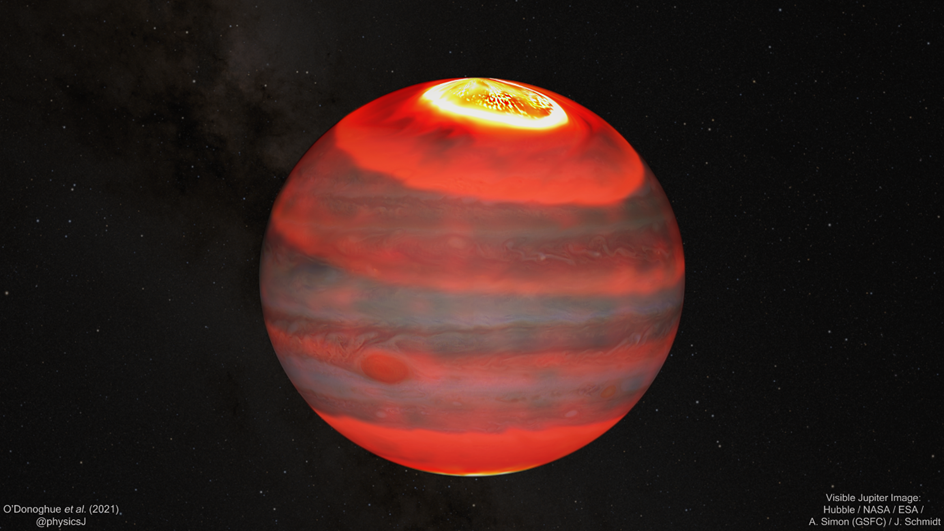
Figure 2: Jupiter is shown in visible light overlaid with an artistic impression of the Jovi-an upper atmosphere's infrared glow. The brightness of the upper atmosphere corre-sponds to temperature. From hot to cold: white, yellow, bright red, dark red. The aurorae are the hottest regions and show how heat may be carried by winds away from the auro-ra and cause planet-wide heating.
From orbit around the Earth, JAXA’s Hisaki satellite has observed the aurora-generating magnetic field around Jupiter since the mission’s launch in 2013. This long term monitoring has revealed that Jupiter’s magnetic field is strongly influenced by the solar wind; a stream of high energy particles that emanates the Sun. The solar wind carries its own magnetic field and when this meets Jupiter’s planetary field, the latter is compressed. Further evidence for this interaction and the resultant heating was found when the team observed an extended high temperature region of gas that appeared to be propagating from the aurora. At the time of observation, pressure from the solar wind was particularly high at Jupiter and the field compression is likely to have created an enhanced aurora. The resulting heat wave was the structure spotted by the team as it began to move away towards lower latitudes. "It was pure luck that we captured this potential heat-shedding event,” notes O’Donoghue. “If we’d observed Jupiter on a different night, when the solar wind pressure had not recently been high, we would have missed it!” The discovery of the temperature gradient extending between Jupiter’s auroral region and equator may end the planet’s “energy crisis”. However, while auroras are expected phenomenon on giant gaseous words, the complex state of their winds may determine how effective the heat source is on different planets. Journal paper informationArticle title: Global upper-atmospheric heating on Jupiter by the polar aurorae Journal title: Nature Date of publication: 5 August 00:00 (JST)
DOI: 10.1038/s41586-021-03706-wExternal Link
Authors:
Links:
|
July 2021
Jul. 28, 2021 Updated
“JAXA-NASA Cooperation in Addressing the Climate Challenge” (Webinar) now viewable on YouTube
|
On July 21, JAXA Washington D.C. Office hosted the online webinar, “JAXA-NASA Cooperation in Addressing the Climate Challenge.” During the event, Dr. Gavin Schmidt, Senior Climate Advisor (Acting) of NASA, and Prof. Tadahiro Hayasaka, Senior Advisor of JAXA’s Earth Observation Research Center (EORC), presented current and future climate missions of JAXA and NASA. They also discussed the importance of international partnership in addressing climate change. Any member of the public can now watch the recording of this seminar on YouTube. To view the video or for more information, visit:https://www.youtube.com/watch?v=la6mEEaTWWQ. 
Prof. Tadahiro Hayasaka (Upper left), Dr. Gavin Schmidt (Upper right), and Dr. Masami Onoda, Director of JAXA Washington D.C. Office (Moderator) (Bottom) |
Jul. 16, 2021 Updated
JAXA and UNOOSA open 7th Round of KiboCUBE program!
|
Japan Aerospace Exploration Agency (JAXA) and the United Nations Office for Outer Space Affairs (UNOOSA) is pleased to announce the opening of the 7th round of KiboCUBE program. This program offers an opportunity for the selected entity located in developing countries to deploy 1U CubeSat (10cm3-sized small satellite) from the Japanese Experiment Module “Kibo” of the International Space Station (ISS). So far, 6 winners have been selected in this program, out of which 3 winners have successfully deployed their CubeSats from Kibo. Please see the below UNOOSA website for more detail. https://www.unoosa.org/oosa/en/ourwork/access2space4all/KiboCUBE/KiboCUBERounds.htmlExternal Link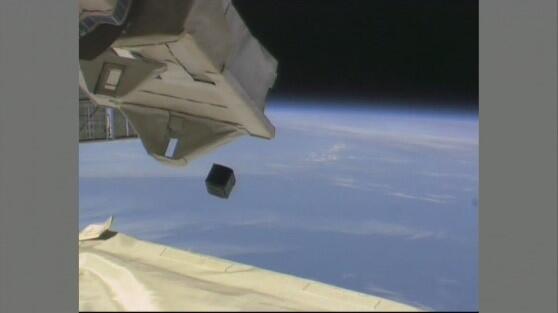
CubeSat “MIR-SAT1” (the 3rd round winner) deployed from the ISS (2021/06/22) 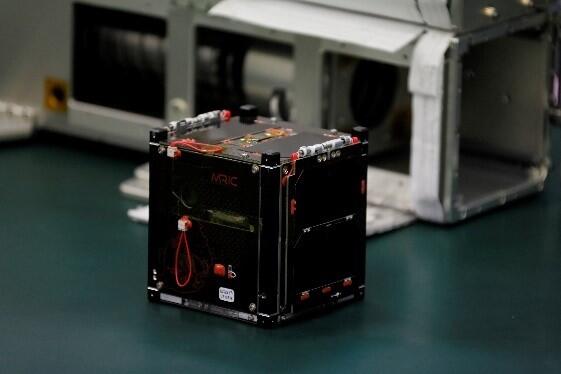
CubeSat “MIR-SAT1” developed by Mauritius Research and Innovation Council |
Jul. 2, 2021 Updated
Memorandum of Understanding with National Aeronautics and Space Administration (NASA) for cooperation on JAXA CubeSats on Artemis I
|
The Japan Aerospace Exploration Agency (JAXA) and the National Aeronautics and Space Administration (NASA) agreed to cooperate on the launch and data exchange for the two JAXA CubeSats on July 2, 2021. Dr. KUNINAKA Hitoshi, Vice President of JAXA/Director General of Institute of Space and Astronautical Science(ISAS) and Ms. Karen Feldstein, Associate Administrator for International and Interagency Relations of NASA signed a Memorandum of Understanding. 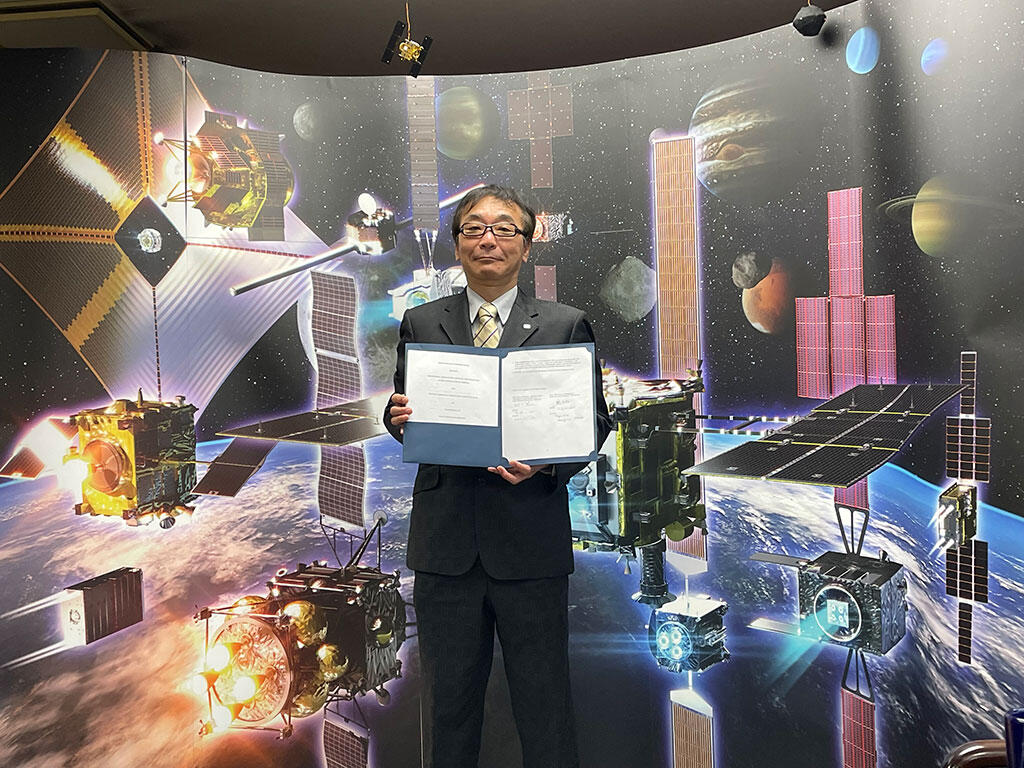
On Artemis I, NASA plans to demonstrate its new Space Launch System (SLS) rocket for the first time and send an uncrewed Orion spacecraft into deep space. NASA also plans to take advantage of additional available mass and volume to provide the opportunity to send small satellites, called CubeSats, into space to conduct experiments for future exploration. JAXA’s EQUULEUS(EQUilibriUm Lunar-Earth point 6U Spacecraft) and OMOTENASHI(Outstanding MOon exploration TEchnologies demonstrated by NAno Semi-Hard Impactor)are two of the CubeSats that are planned to launch as part of the Artemis I mission.
For more information, visit:
EQUULEUS:
Artemis:
|
June 2021
Jun. 25, 2021 Updated
JAXA and United Kingdom Space Agency (UKSA) Sign Memorandum of Cooperation
|
President Yamakawa of JAXA and Chief Executive Dr. Graham Turnock of the United Kingdom Space Agency (UKSA) have signed today a Memorandum of Cooperation Regarding Aerospace Cooperation for Peaceful Purposes (MOC). The signing ceremony was graced by the presence of H.E. Ms. Julia Longbottom, Ambassador of the United Kingdom to Japan, and H.E. Mr. Hayashi Hajime, Ambassador of Japan to the United Kingdom.
Based on a successful track record of bilateral cooperation and the mutual desire to enhance future collaboration, the MOC promotes cooperation between the two space agencies in a wide range of areas such as aerospace research and development, space science and exploration, earth observation and satellite applications, and the sustainable and safe use of the orbital environment.
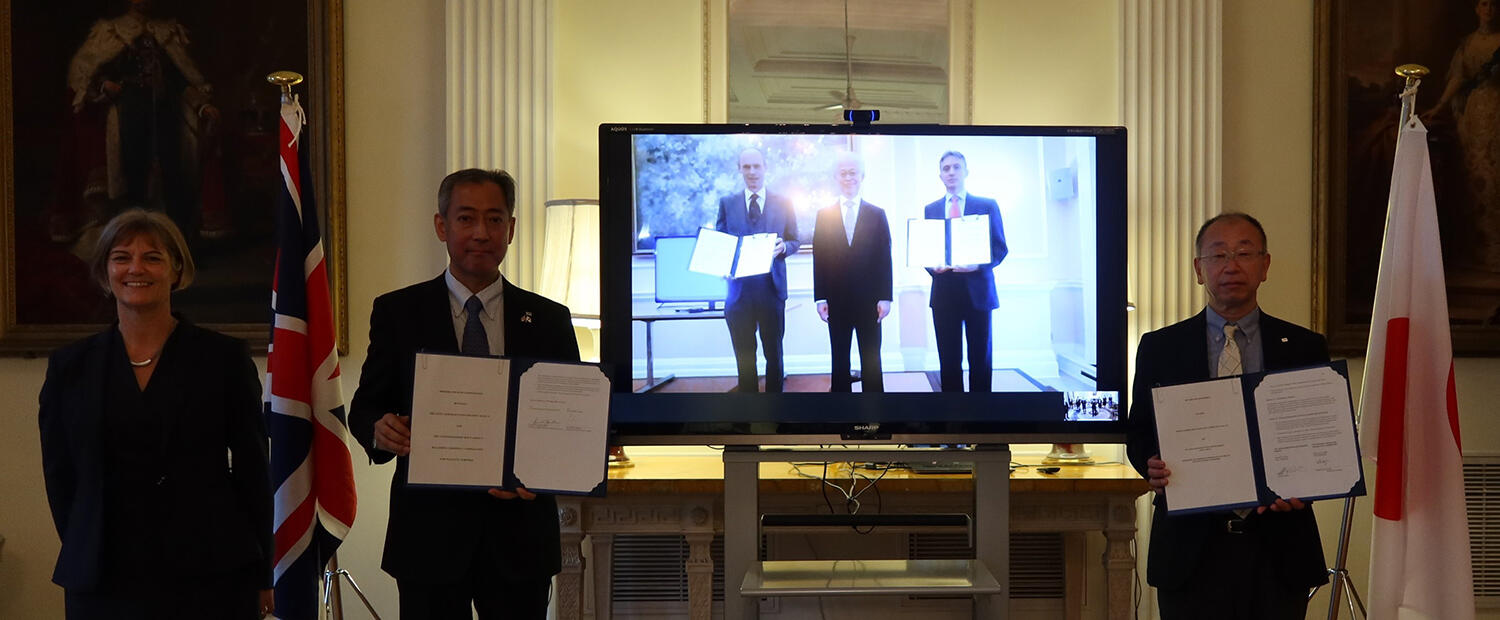
(left to right)
|
Jun. 14, 2021 Updated
JAXA and Philippine Space Agency (PhilSA) Sign Memorandum of Cooperation
|
President Yamakawa of JAXA and Director General Marciano of the Philippine Space Agency (PhilSA) have signed today a Memorandum of Cooperation (MOC) on Space Development and Application. The signing ceremony was graced by the presence of H.E. Mr. Jose Castillo Laurel V, Ambassador of the Republic of the Philippines to Japan, and H.E. Mr. Koshikawa, Ambassador of Japan to the Philippines. At the closure of the signing ceremony, Secretary Fortunato T. de la Peña of the Department of Science and Technology (DOST) also gave a congratulatory address. JAXA has been building a close cooperative relationship with the Philippines since before the establishment of PhilSA through its promotion of disaster management-related research in the Philippines, the deployment of PHL-Microsat-1 or “DIWATA-1,” the first Philippines-made microsatellite, from the Japanese Experiment Module "Kibo" on the International Space Station in 2016, and the launch of the PHL-Microsat-2 or "DIWATA-2" onboard the H-IIA launch vehicle in 2018. With the conclusion of this MOC, the two organizations will further strengthen their cooperation. 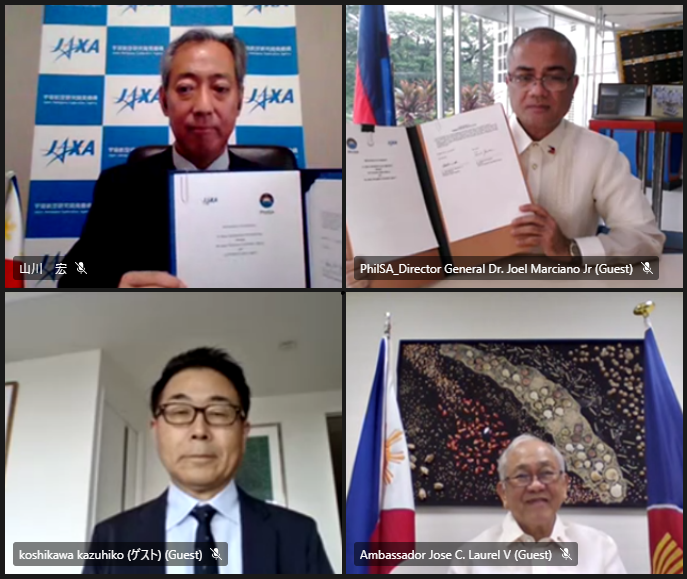
President Yamakawa of JAXA (Top left)
|
Jun. 8, 2021 Updated
Dr. Yamakawa's Meeting with Centre National d’Études Spatiales CEO Philippe Baptiste
|
Dr. Yamakawa, President of Japan Aerospace Exploration Agency (JAXA), and Dr. Philippe Baptiste, Chair and Executive Officer of Centre National d’Études Spatiales (CNES), met virtually on June 7, 2021.

|
May 2021
May 21, 2021 Updated
Online Courtesy Call with NASA Administrator, Sen. Nelson
|
Dr. YAMAKAWA Hiroshi, President of Japan Aerospace Exploration Agency (JAXA), Minister INOUE Shinji of State for Space Policy of Japan, and Minister HAGIUDA Koichi of Ministry of Education, Culture, Sports, Science and Technology of Japan had a courtesy call with National Aeronautics and Space Administration (NASA) Administrator, Sen. Bill Nelson on May 21, 2021. This was the first call for NASA with an international partner since Sen. Nelson was sworn in as the Administrator on May 3. The importance of Japan-U.S. space cooperation and necessity of strengthening partnership was reaffirmed at the call. 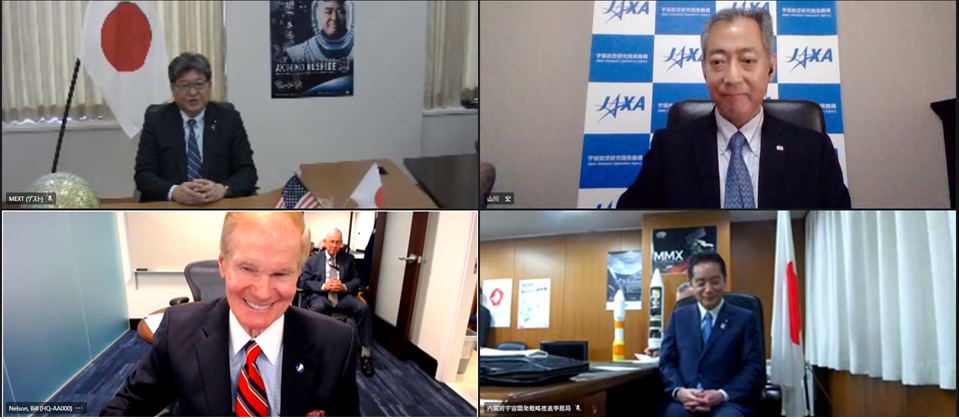
Online courtesy call (upper left: Minister HAGIUDA, upper right: Dr. YAMAWAKA, |
March 2021
Mar. 24, 2021 Updated
Bilateral Meeting with the Australian Space Agency (ASA)
|
Dr. Yamakawa, the President of JAXA, and Mr. Palermo, the Head of ASA, held an online bilateral meeting on March 22, 2021. During the meeting, the two sides shared information on their future plans and exchanged views on the possibility of cooperation in the fields of international space exploration and space science. Since the signing of the Memorandum of Cooperation (MOC) between JAXA and ASA in July last year, space cooperation between the two countries has been a topic of discussion at the summit meeting. Building on the cooperation established in the “Hayabusa2” capsule recovery mission, the two agencies concluded the meeting by confirming that they will further promote cooperation and contribute to the realization of a free and open Indo-Pacific region. 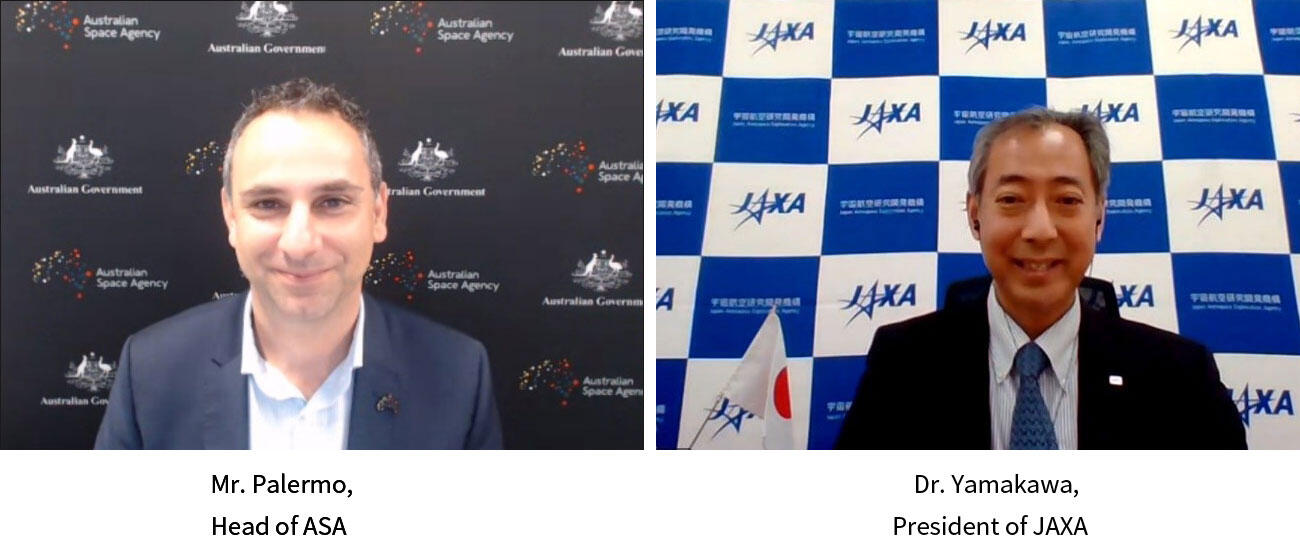
|
Mar. 15, 2021 Updated
Bilateral meeting between JAXA and ISRO
|
An online top-level meeting between Dr. YAMAKAWA Hiroshi, President of the Japan Aerospace Exploration Agency (JAXA), and Dr. K. Sivan, Chairman of Indian Space Research Organisation (ISRO), was held on March 11, 2021. At the meeting, both agencies updated each other on their recent space activities and future plans, and confirmed the progress of ongoing joint cooperative projects such as the Utilization of Earth Observation Satellite Data, which aims to use Earth observation data to monitor heavy rainfall and rice-crop outlook, and the Lunar Polar Exploration Mission, which investigates water, a critical element for sustainable human activities on the Moon. It has been 5 years since the signing of a Memorandum of Understanding (MoU) between JAXA and ISRO, and the two agencies concluded the meeting by confirming that their mutual understanding has deepened and cooperation has expanded, and that they will continue to strengthen their cooperative relationship going forward. 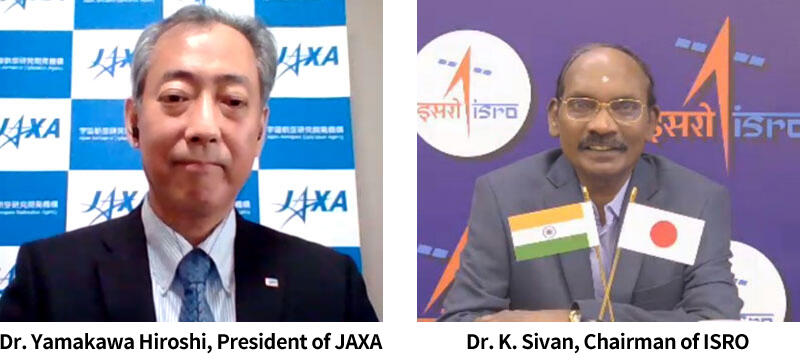 Taking the opportunity of this meeting, both agencies signed an Implementation Arrangement (IA) on rice crop planted area monitoring and air quality monitoring. The two agencies will jointly conduct research to improve the data accuracy on the yields of paddy rice, which is a staple food in Asia, as well as aerosols, which impacts air quality. 
Mr. Terada Koji, Vice President of JAXA and Mr. Shantanu Bhatawdekar,
|
Mar. 15, 2021 Updated
JAXA and AEP Sign Letter of Intent
|
Dr. YAMAKAWA Hiroshi, President of Japan Aerospace Exploration Agency (JAXA) and Cnel. DEM (R) Liduvino Vielman Díaz, President of the Paraguayan Space Agency (AEP) signed a Letter of Intent (LOI) on March 14, 2021. It was signed on the same day the first Paraguayan satellite GUARANISAT-1 successfully deployed from the International Space Station (ISS) Japanese Experiment Module (KIBO) into orbit. Based on this LOI, JAXA and AEP have confirmed mutual intention to start dialogues to explore possibilities of cooperation in space activities for peaceful purposes. 
Signing the LOI (left: Cnel. DEM (R) Liduvino Vielman Díaz, AEP President / right: Dr. YAMAWAKA Hiroshi, JAXA President) |
Mar. 4, 2021 Updated
GSMaP receives "Dr. Roman L. Kintanar Award 2020" for significant contribution to Typhoon Committee's regional flood forecasting
|
The joint team of the International Centre for Water Hazard and Risk Management (ICHARM), the Infrastructure Development Institute (IDI) and JAXA was given the “Dr. Roman L. Kintanar Award for Typhoon-Related Disaster Mitigation - 2020”. The Dr. Roman L. Kintanar Award is given annually to an organization that has made a significant contribution to the activities of the Typhoon Committee, an inter-governmental body established under the United Nations Economic and Social Commission for Asia and the Pacific (ESCAP) and the World Meteorological Organization (WMO) to reduce the damage caused by typhoons. JAXA has developed the Global Satellite Mapping of Precipitation (GSMaP). The GSMaP has contributed significantly to flood prediction in the Typhoon Committee Region. This is the first time that Japanese organizations, other than the Japan Meteorological Agency, got the award. 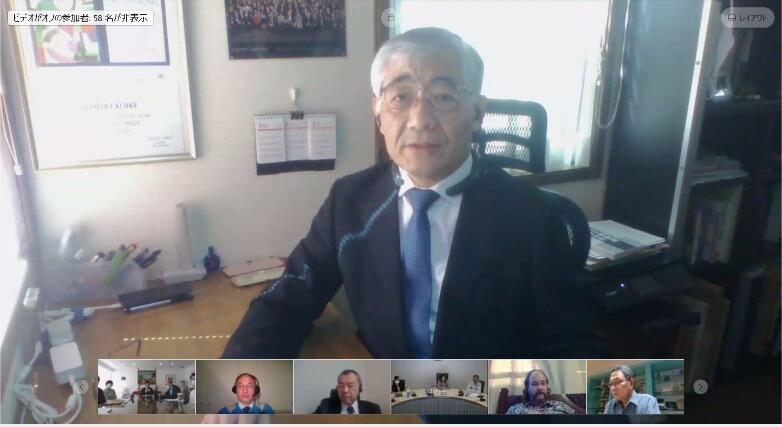
Acceptance speech by ICHARM Executive Director KOIKE at the 53rd session of the 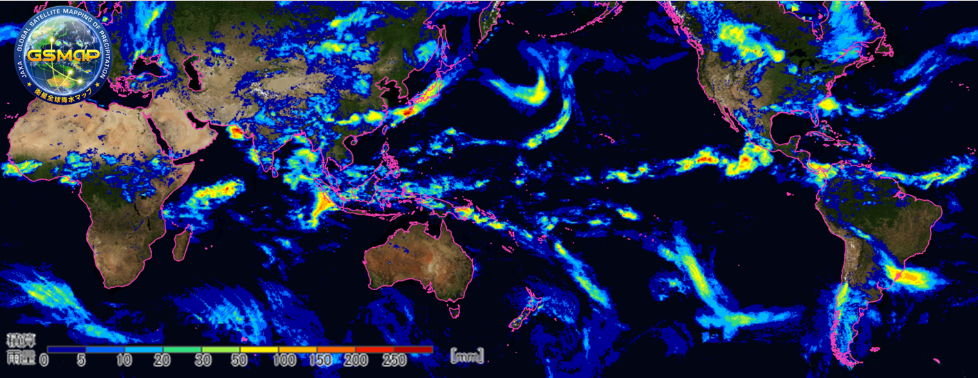
The GSMaP is a global rainfall map developed by combining the multi satellites under the Global Precipitation Measurement (GPM) mission. The users have spread to 138 countries in the world, and the GSMaP is being used in various fields such as precipitation monitoring, flood forecasting, drought monitoring, agriculture, and so on.
|
Mar. 2, 2021 Updated
Creating water simply on the surface of a celestial body
|
A research team led by Yusuke Nakauchi (JAXA) have conducted experiments which demonstrated that water molecules (H2O) can be generated on the Moon and in the surface layer of small bodies when hydrogen ions emitted from the Sun collide with the silicate material (the main mineral found on the Earth, Moon and other small celestial bodies) of the lunar surface. |
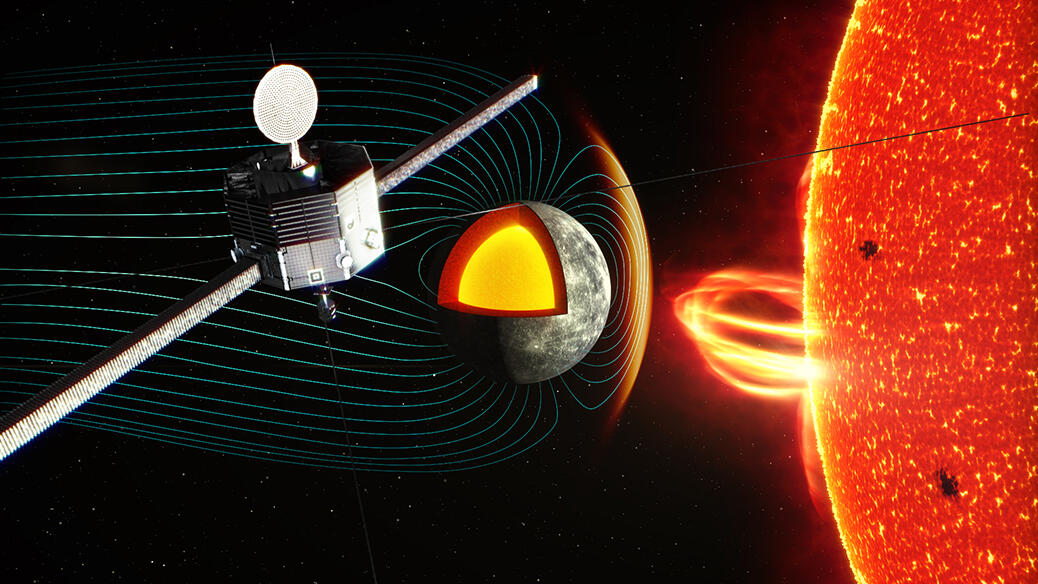
|
|---|
February 2021
Feb. 26, 2021 Updated
Bilateral meeting between JAXA and CNES
|
Dr. YAMAKAWA Hiroshi, President of the Japan Aerospace Exploration Agency (JAXA) and Dr. Jean Yves Le Gall, President of National Centre for Space Studies (CNES), held an online bilateral meeting on February 25, 2021. Dr. Yamakawa shared the successful sample return from asteroid “Ryugu” by Asteroid Explorer Hayabusa2 with Dr. Le Gall and expressed his gratitude to CNES for its cooperation in providing MicrOmega, the infrared spectroscopy microscope for the analysis of samples from asteroid “Ryugu”. The status of cooperative activities between the two agencies was also confirmed, including that of Earth Observation, Space Science and Space Transportation. Dr. Yamakawa agreed with Dr. Le Gall to promote the JAXA-CNES relationship further. 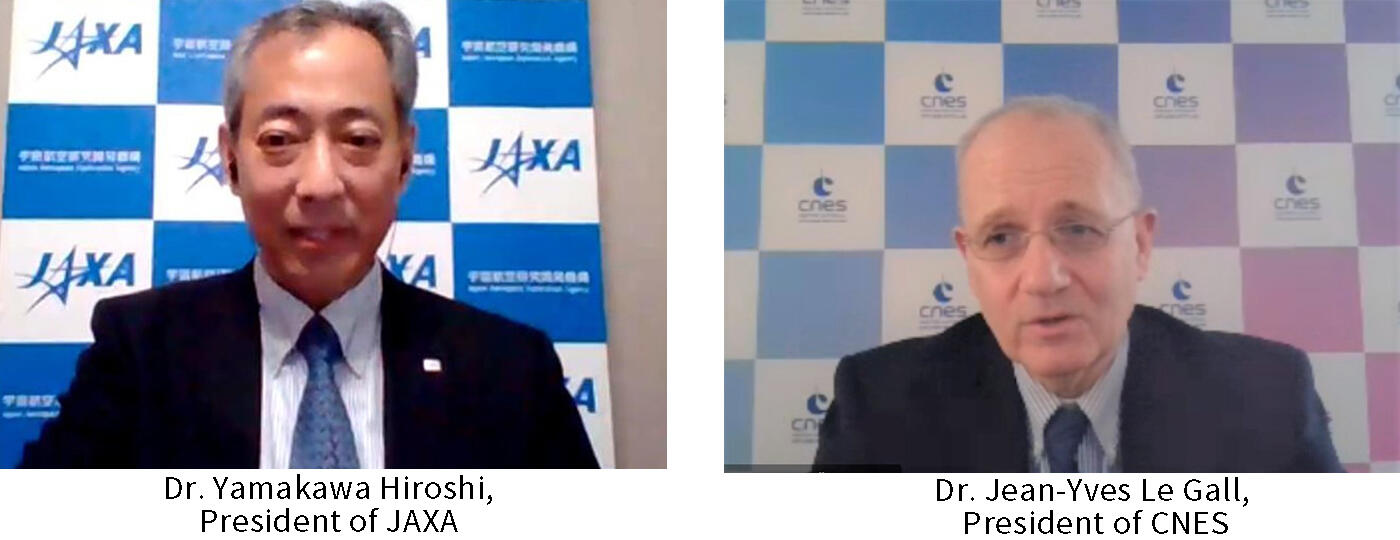
|
Feb. 22, 2021 Updated
Sounding Rocket CLASP2 Elucidates Solar Magnetic Field up to the Base of the Corona
|
For the first time, an international research team has revealed the magnetic structure from the solar surface to the base of the corona, combining observations from the sounding rocket experiment, CLASP2, with that of the Hinode satellite. The CLASP2 instrument was developed through the joint efforts of Japan, the US, and Europe and was launched with the NASA sounding rocket on April 11, 2019. For 6.5 min, CLASP2 succeeded in observing the polarization in the ultraviolet (UV) originating from the solar chromosphere. At the same time, Hinode, which has been operated by ISAS/JAXA under international and domestic collaboration, captured the magnetic field distributed on the solar surface with high accuracy. This unprecedented duel observation revealed that confined flux tubes scattered on the solar surface rapidly expanded and merged with one another (Fig. 1). This study provides new insight into solar magnetic fields and opens up a new diagnostic window for chromospheric magnetic fields. On 19 February, this result appeared in “Science Advances,” a peer-reviewed journal in the Science (Magazine) family published by American Association for the Advancement of Science. Main TextThe outer solar atmosphere, the chromosphere (10,000 K), and the corona (1 MK), are home to extremely high temperatures compared with the solar surface (6,000 K), and the mechanism to generate such high-temperature atmospheres is not yet understood. Moreover, the plasma density of the chromosphere is higher than that of the corona, suggesting that much more energy is required to maintain the chromosphere than the corona. These are known as “chromosphere and coronal heating problem.” Various observational and theoretical investigations have been conducted to address this problem, and the chromosphere, which is the interface between the solar surface and the corona, has been known to play a critical role. However, the magnetic field in the chromosphere, which drives the fundamental processes for heating such as dynamical plasma motions and transfer of energy to the upper layers, has not been extensively measured, and the lack of information has prohibited solar physicists from understanding the issue. New instruments aimed at the measurement of chromospheric magnetic fields are being actively developed worldwide. Motivated by recent theoretical investigations on the magnetic sensitivity of the solar ultraviolet (UV) spectrum, the international CLASP and CLASP2 team focused on the polarization in the strongest UV spectral lines: hydrogen Lyman-alpha and Mg II h & k. UV polarization has been unexplored for many years since the measurement requires observation from space and the technology needed to precisely measure the polarization in UV light was not yet mature. The team has overcome these difficulties and conducted the sounding rocket experiments CLASP (for the Lyman-alpha line) in 2015 and CLASP2 (for the Mg II h & k region) in 2019. The CLASP2 international research team carried out the investigation published in Science Advances. The investigation has been coordinated by Ryohko Ishikawa (National Astronomical Observatory of Japan, NAOJ) and Javier Trujillo Bueno (Instituto de Astrofísica de Canarias, IAC). During the observing time of 6.5 min, CLASP2 observed the active region for 2.5 min and succeeded in obtaining the polarization spectra around the Mg II lines (wavelength 280 nm) for the first time (Fig. 2). Interestingly, in addition to the Mg II lines, which are the primary spectral lines targeted by CLASP2 (indicated as Mg II k and Mg II h in Fig. 2), two Mn I lines also showed clear circular polarization signals. While the Mg II lines originate from the middle to the top of the chromosphere, the Mn I lines are emitted from the lower chromosphere. By exploiting the polarization signals in these spectral lines, magnetic field measurements at different heights in the chromosphere (i.e., bottom, middle, and top of the chromosphere) are possible. Moreover, CLASP2 succeeded in coordinated observation with the Hinode satellite, which precisely measured the magnetic field on the solar surface (lower left panel of Fig. 2). By combining the observations of CLASP2 with that of the Hinode satellite, the magnetic structure from the solar surface to the top of the chromosphere was revealed (Fig. 3). The spatial variation of the magnetic field on the solar surface with large amplitudes (green line in Fig. 3) shows that the confined flux tubes are scattered on the solar surface. On the other hand, the spatial variations of the chromospheric magnetic fields (blue, black, and red circles in Fig. 3) show different behaviors: [1] the field strengths in the chromospheric layers dramatically weaken compared with those on the solar surface, [2] the higher the chromosphere, the weaker the field strength, [3] the chromosphere harbors relatively strong magnetic fields in the location where the magnetic field is weak on the surface (black arrow shows one example). Based on these observational results, it has been revealed that flux tubes rapidly expand in the chromosphere and merge with adjacent flux tubes (Fig. 1). Such a picture had been speculated by solar physicists for many years, but the observational evidence had not yet been obtained. Moreover, the team found a high correlation between the energy density (the product of electron density and temperature), which was inferred from the intensity (upper right panel of Fig. 2) and the magnetic fields at the top of the chromosphere (red circles in Fig. 3). This high correlation provides empirical evidence that chromospheric heating is of magnetic origin and that chromospheric magnetic fields, rather than those on the solar surface, are indispensable for understanding the heating mechanism. It is anticipated that the inferred picture of magnetic flux tubes connecting from the solar surface to the top of the chromosphere will allow deciphering how the magnetic field couples the different atmospheric layers, i.e., investigation of how energy is transferred between different layers of the Sun. The CLASP2 instrument was launched by a NASA sounding rocket in the White Sands Dessert, New Mexico (Fig. 4). The instrument payload landed on the White Sands Desert using a parachute and was transported back to NASA/MSFC. The CLASP2 team plans to fly the instrument again as CLASP2.1. In CLASP2, the spectrograph slit was fixed at one location, and information about the magnetic fields along a single line on the Sun was obtained. In CLASP2.1, the team aims at obtaining the 3D (spatial 2D & height) map of the magnetic fields from the solar surface to the top of the chromosphere by moving the slit. Sounding rocket experiment provides a unique chance for researchers with a scientific idea to plan and develop the instrument, and execute this in a prompt and timely manner. Hence it is particularly valuable for pioneering research and technology demonstrations that may evolve into satellite mission concepts in the future. It also provides an efficient opportunity to educate young researchers and graduate students who will lead instruments in future satellite missions. Solar physicists all over the world likewise are pursuing chromospheric magnetic field measurements with upcoming new instruments such as the SUNRISE-3 balloon project, the recently-completed DKI Solar Telescope in Hawaii and the future European Solar Telescope (EST) in Canary Islands. Finally, it is critically important to simultaneously observe the heating process in greater detail. The new solar satellite mission, Solar-C Extreme Ultraviolet High-Throughput Spectroscopic Telescope (EUVST), which is being developed by Japan in close collaboration with the US and European partners, will be able to perform spectroscopic observations of the chromosphere to the corona with high spatial and temporal resolutions (though without polarization diagnostics). Solar physicists are excited to tackle the ‘chromospheric and coronal heating problem’ by exploiting various observational facilities and diagnostic methods. Appendix・Magnetic field measurements and chromospheric magnetic field ・CLASP (Chromospheric Lyman-Alpha Spectro-Polarimeter)
・CLASP2 (Chromospheric LAyer Spectro-Polarimeter) ・Active region ・Zeeman effect 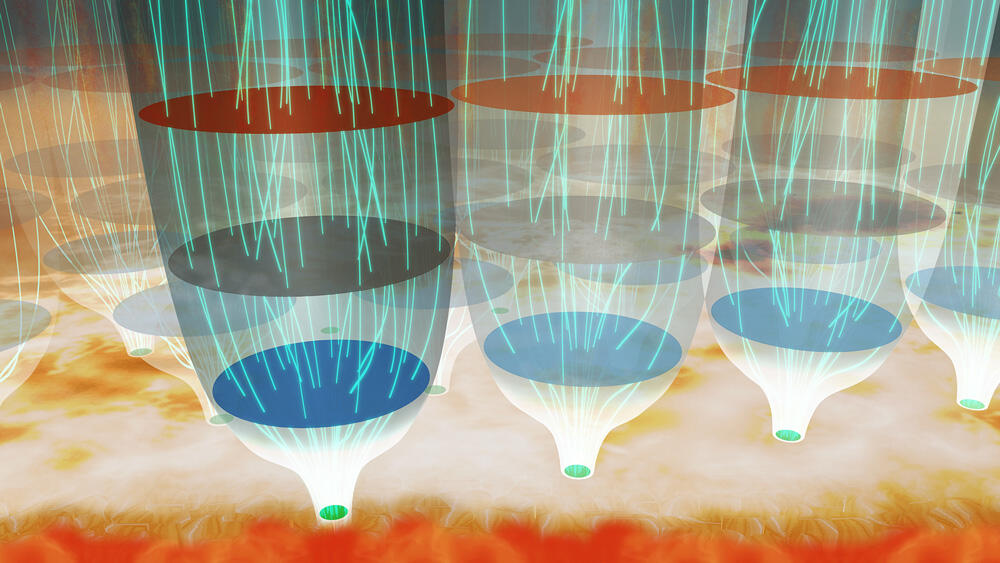
Fig.1:Measuring the magnetic field strength at four different heights by using data from the CLASP2 and Hinode allowed mapping of the spread of magnetic field lines in the plage chromosphere (Credit: NAOJ). 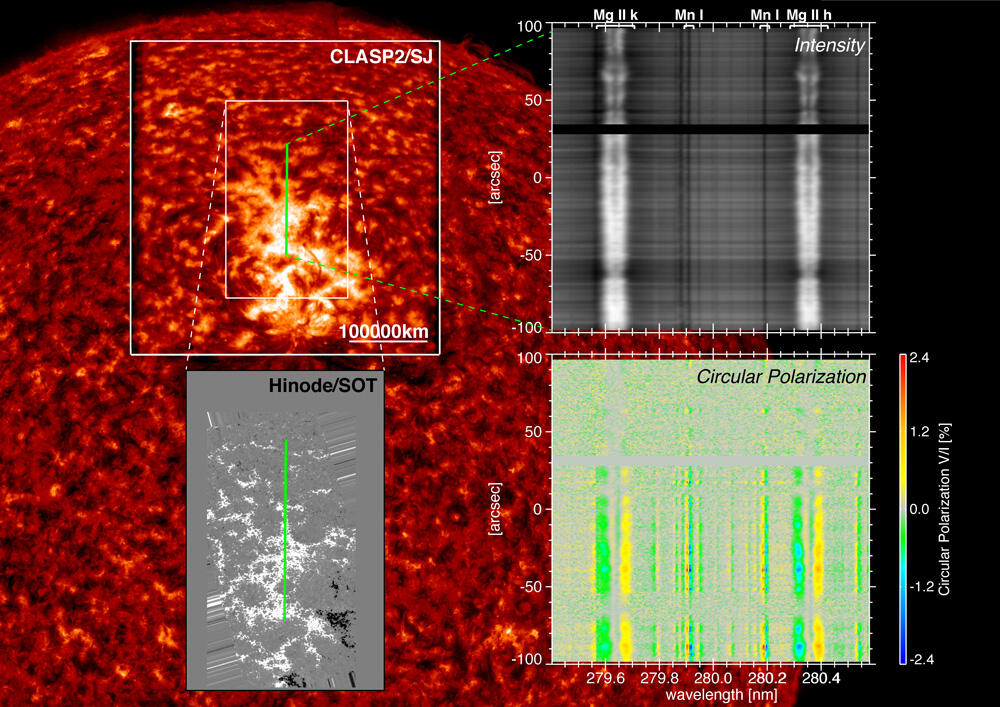
Fig.2:Summary of data used in this study. CLASP2 obtained the polarization spectra (right two panels) at the location of the slit shown by the green solid line. The solar chromosphere around the CLASP2 slit was monitored by the Slit-Jaw monitor system (SJ) aboard CLASP2 (upper left panel). The detailed magnetic field information on the solar surface was recorded by the Solar Optical Telescope aboard the Hinode satellite (lower left panel), where the white and black show the strong magnetic fields with N- and S- polarities. In the background is the full disk image of the solar chromosphere taken by the Solar Dynamic Observatory (SDO) satellite. (Credit: NAOJ, IAC, NASA/MSFC, IAS) 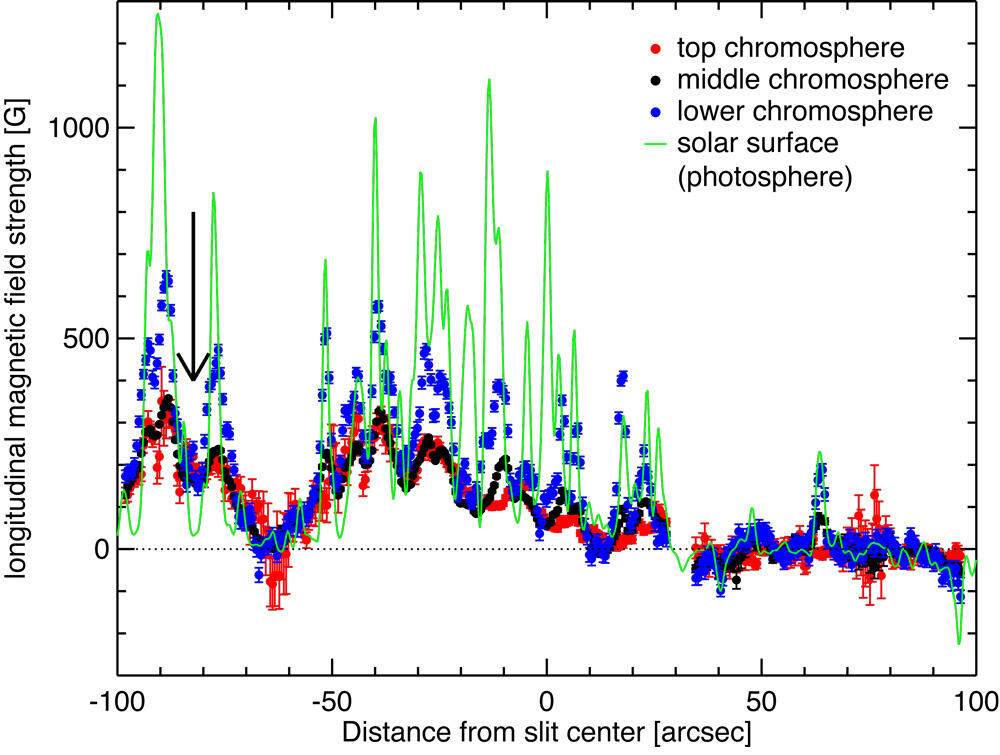
Fig.3:Mapping of the magnetic fields from the solar surface to the base of the corona (top chromosphere), along the CLASP2 slit (green solid line in Fig. 2) at four different heights of the solar atmosphere. (Credit: NAOJ, IAC, NASA/MSFC, IAS) 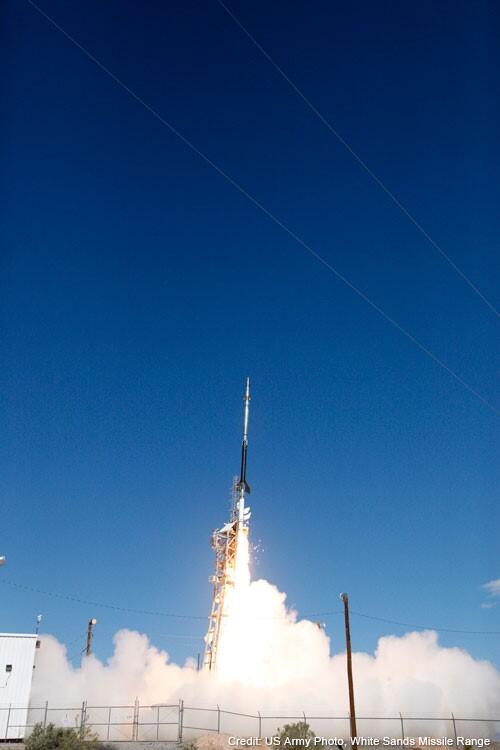
Fig.4:Launch of the CLASP2 sounding rocket. Credit: US Army Photo, White Sands Missile Range Paper“Mapping Solar Magnetic Fields from the Photosphere to the Base of the Corona” The CLASP2 international research team:Ryohko Ishikawa (NAOJ, Japan) Acknowledgments for research grantsCLASP2 is an international partnership between NASA/MSFC, NAOJ, JAXA, IAC, and IAS; additional partners include ASCR, IRSOL, LMSAL, and the University of Oslo. The Japanese contribution to CLASP2 was supported by:
The contribution of Spain to CLASP2 was supported by:
The contribution of France to CLASP2 was supported by:
Related links
|
Feb. 15, 2021 Updated
Call for team participation in the 2nd Kibo Robot Programming Challenge (Kibo-RPC)
|
The Japan Aerospace Exploration Agency (JAXA) will host a programming competition involving free-flying robots of JAXA and NASA in ISS/Japanese Experiment Module (JEM) known as "Kibo". JAXA is pleased to announce that the call for team participation has been open. 【Entry details and application】
【Deadline】May 16, 2021 at 23:59 (JST) 【Entry Qualification】Students up to graduate school students in Kibo-ABC member countries including Japan. 
|
Feb. 5, 2021 Updated
Bilateral meeting between JAXA and ESA
|
Dr. YAMAKAWA Hiroshi, President of the Japan Aerospace Exploration Agency (JAXA) and Dr. Jan Wörner, Director-General of European Space Agency (ESA), took part in an online bilateral meeting on February 4, 2021. The status of cooperative activities between the two agencies was confirmed, including that for Earth Observation, Space Science and Space Exploration. Taking the opportunity of this bilateral meeting, two agreements concerning the cooperation on Hera, an ESA-led mission, and MMX, a JAXA-led mission, were concluded. Hera is an ESA-led international planetary defense mission to carry out observations of NASA’s DART mission’s impact on the binary asteroid Didymos. Under this agreement, JAXA contributes to the mission by providing the thermal infrared camera and science collaboration. See below for the detail of the Hera mission.
MMX is JAXA’s exploration mission, which plans to collect a sample from the Martian moon, Phobos, to bring back to Earth. |

